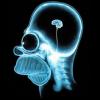From the interview (most important parts imo):
"The company has just announced that phase 1 b results will be reported at the 29th Annual CINP World Congress of Neuropsychopharmacology in Vancouver, Canada at 5:15 PDT on June 24, 2014. The title of the poster is: “Effects of NSI-189, a neurogenic compound, on quantitative electroencephalography (qEEG) in patients with major depressive disorder (MDD) during a phase 1b randomized, double-blind, placebo controlled, multiple ascending dose study”
We believe we are reversing hippocampal atrophy and most likely increasing synaptagenesis in the hippocampus.
Neuralstem will be developing other small molecule drugs to treat neurodegenerative, cognitive as well as neuropsychiatric, disorders.
This drug may actually structurally rebuild the hippocampus, inducing up to a 20% increase in hippocampal volume if results in animal models are replicated i n humans. We believe this is due to synaptogenesis. This is the world’s first truly neurogenic drug that is designed to specifically increase the number of synapses in the hippocampus. But as with all neuroscience, the story is complicated, not simple. While we are seeing synaptagenesis, it may well be that there are also overlapping pathways providing benefit. We are teasing out that data now.
SmithOnStocks:
What can you tell us about the phase 1b program?
Richard:
Well, not much right now. We have completed the phase 1b dose escalating study of NSI-189. The study used MRI scans at baseline and later to determine if there was an enlargement of the hippocampus. We used quantitative EEG measurements as both a safety measurement and a possible biomarker that could confirm efficacy if it was seen because there is a correlation between certain signals that the EEG picks up in specific regions of the brain, and efficacy with depression drugs. We also measured many of the standard depression behavioral tests that are used in the industry. The dosing was 28 days, and the patients were in the hospital center the entire time.
SmithOnStocks:
It was my impression that you were going to release the phase 1 data after the trial was completed and data analyzed which appears to have been finished? Why haven’t we seen the data?
Richard:
I am restricted in what I can say right now about that. The only thing we have said publicly is that it will probably take us through May or a little longer to crunch all the data; but that the early look was encouraging enough that we have already committed to conducting a phase two trial. I might also point out that we recently added Catherine Sohn to our Board of Directors. Cathy ran all commercialization for Glaxo for 8 years, and earlier in her career actually launched Paxil, one of the all time most successful depression drugs. Finally, it has been made public on the CINP web site that one set of data from the 1b trial will be presented in a session on June 24th entitled.
SmithOnStocks:
What are your thoughts on partnering NSI-189?
Richard:
We have stated in the past that we would partner NSI-189 after the 1b data was available.
From a practical point of view, there has been little appetite for partnering before proof of principal data is available; and we are actively gearing up for such an effort as soon as all the phase 1b data is in and reviewed. For partnering purposes, it may be more advantageous to partner after a phase 2 trial, but Neuralstem until recently lacked the financial resources. The Company now has the resources to conduct the phase 2 which we anticipate starting later this year. We still believe the program will benefit from having a partner, but we are not resource constrained if we don’t find a deal that we like
SmithOnStocks:
If you decide to go into phase 2 without a partner, could you describe what the trialmight look like, the timeline for completion and the cost.
Richard:
It probably will look something like a 250 patient trial that will take 18 months to 24 months to complete and cost somewhere between $5 million and $10 million dollars.
SmithOnStocks:
Do you have any closing thoughts on how investors should look at the NSI-189 opportunity?
Richard:
Again, I think they should think of it as a second declared asset along with the spinal cord cell therapy product. The company has historically spent 50% of its resources on this platform and I believe it has b een given little if any value in the way investors look at the company. I believe that is a great misunderstanding of where this program is, and where it could be headed"





















































